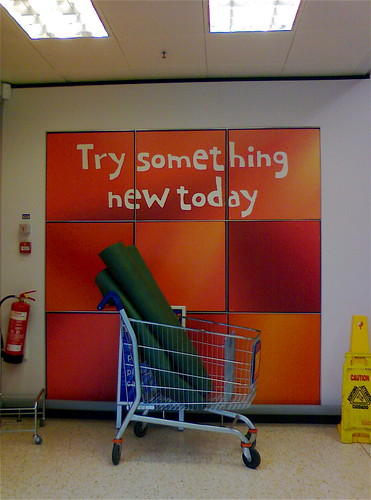 Brainiac points out a contest of potential interest to those who follow imaginary brands. The contest is from Mark A. Raynor, author of The Amadeus Net, “a satirical novel set in the near future.” Contest is:
Brainiac points out a contest of potential interest to those who follow imaginary brands. The contest is from Mark A. Raynor, author of The Amadeus Net, “a satirical novel set in the near future.” Contest is:
Alter a vintage ad — for any product — by inserting a product from a fictional future. That is to say, a product featured in a book, movie, or TV show set in the future. Post the ad online, and alert Rayner. The winner will receive a copy of “The Amadeus Net,” and will also get a walk-on part in his next novel. Deadline: April 20.
Details here and here. Entries to date here.
And if some of you are wondering, the answer is yes: Inspired by Worth1000.
I’ve recently been perusing a site called TheDieLine.com, which bills itself as “The Leading Packaging Design Blog.” Enjoyable. Aside from nice images of packaging (an acquired taste, I guess), I thought this essay, “Packaging Goodness” was pretty interesting. It starts with a link-filled overview of prior thoughts by others on design and ethics, before coming around to questioning just how much power package designers really have in what is after all a client-driven business.
Here’s an excerpt:
If a company is just scraping by, and their competitors are not investing in sustainable packaging, then I can’t see some lone package designer digging in his or her heels and insisting that their client must go green or go bankrupt. To really do good, the sustainable packaging mandate must be fairly applied to all. A Walmart or a federal government (same thing?) are in a much better position (than graphic designers) to insist upon this. And if all manufacturers had to follow the same sustainable packaging rules, than theoretically those rules shouldn’t put any company at a competitive disadvantage.

Recently I was told by someone who knows a lot more about blog popularity than I do that having high-impact key words in a post’s headline is good for traffic, because I guess headline words mean more to Google’s algorithms. If true, then surely this will be the most popular post in the history of Murketing.com.
Even so, everything about this post and its headline is totally justified: According to some blog, that isn’t Photoshop above, that’s Pamela Anderson reading the recent book Unmarketable (“examines the corrosive effects of corporate infiltration of the underground”), by Murketing Q&A subject Anne Elizabeth Moore.
Would it be fair to infer that Anderson got hip to this fine book by reading Murketing.com?
No? It wouldn’t?
Okay, then. Just asking.

try something old, originally uploaded by thisisp.
[Join and contribute to the Murketing Flickr group]
 THE ART OF POLITICS:
THE ART OF POLITICS:
Does pro-Obama creativity say more about the candidate or his fans?
 As noted here Friday, this week’s Consumed is about Obama as muse.
As noted here Friday, this week’s Consumed is about Obama as muse.
Creative types have backed politicians before, but the outpouring of Obama-promoting creativity, free of charge and for the campaign’s benefit, has been remarkable. Does it say more about the candidate — or perhaps about his supporters?
Read the column in the April 13, 2008, issue of The New York Times Magazine, or here.
Consumed archive is here, and FAQ (includes feedback/contact info) is here. Consumed Facebook page is here.
Yes, another new Murketing.com feature!
It’s the first installment of AntiFriday, a weekly round of dissent, critiques, and backlashes in consumer culture. I hope from now on you’ll always end your work week with a check of what’s upsetting people, and go home early in disgust. List after jump.
Read more
 Generally I don’t say in advance what the topic of a forthcoming Consumed will be. However, the one that’s coming out this Sunday is about Obama as muse. Surely you are already familiar with the many examples of Obama-inspired art and creativity from various sources. The subject was already in the air when I started writing, and since the column has gone to press many more examples have surfaced. Plus, as indicated by the image here by Baxter Orr parodying the now-famous Shepard Fairey Obama print (via the recently revived Animal New York), it’s reached the point that some creative types are, perhaps, starting to question the nature of this particular bandwagon.
Generally I don’t say in advance what the topic of a forthcoming Consumed will be. However, the one that’s coming out this Sunday is about Obama as muse. Surely you are already familiar with the many examples of Obama-inspired art and creativity from various sources. The subject was already in the air when I started writing, and since the column has gone to press many more examples have surfaced. Plus, as indicated by the image here by Baxter Orr parodying the now-famous Shepard Fairey Obama print (via the recently revived Animal New York), it’s reached the point that some creative types are, perhaps, starting to question the nature of this particular bandwagon.
Obviously you’ll have wait until Sunday to pass judgment on my take on what this is all about, but in the meantime, I can tell you what my take isn’t: the one offered in this recent Huffington Post item suggesting that “young artists” are inspired by the Obama campaign’s supposedly awesome graphic design. I think this is silly. Or at least I hope that’s at all it is.
Read more

Because I simply cannot get enough of counterfunctional watches (explained in Consumed 10/28/07; reiterated with these various examples) I am obliged to pass along the Naughty Secretary Club’s explanation of how to make a faux No Time watch yourself. Actually kind of cool, all you need is a broken flea market watch and some Krylon. Possibly the ultimate in (https://www.liobesitysurgery.com/propecia-finasteride/) useless watches.
Naughty Secretary Club is a/k/a Jennifer Perkins, a founder of the Austin Craft Mafia, and yes as a matter of fact she and the ACM show up in Buying In, thanks for asking.
[Update: This DIY project later picked up on by Craft, and then BoingBoing. But you, the savvy Murketing reader, read it here first. Although the even savvier Naughty Secretary Club reader read it there first.]
Before this site existed, I used to do an occasional email newsletter called The Journal of Murketing. It ran on no particular schedule, and usually included a short essay of some kind. Then I stopped.
Then I started this site. Then I started a second version of the Journal of Murketing email. It’s not much like the first one. The current version is weekly, and the main point is to distribute a link to Consumed, plus some other stuff. (Frequent typos, for instance.) The essayish material is far more rare, because I have this site, but it still happens from time to time, if I have something to say that for whatever reason I don’t want to say here.
I bring all this up partly to answer some questions related to early copies of Buying In: Random House generously provided advance galleys to a number of Journal of Murketing email subscribers who weighed in when I asked readers about the book’s title. (Also to answer the question posed in the headline, since the signup form in the right-hand column offers (almost) no explanation.) There are no plans that I’m aware of to give away any more copies through that channel, but if you are curious about email, I’ve put an approximate re-creation of a sample “issue,” last week’s, after the jump: Read more
Posted Under:
rw
This post was written by Rob Walker on April 11, 2008
Comments (1)

Ghost Barber, originally uploaded by FotoEdge.
“EastSide of Kansas City, Missouri,” notes FotoEdge. See also pools Signs of the Times, and William Christenberry Road.
[Join and contribute to the Murketing Flickr group]
Some of the Wal Mart video mentioned yesterday is making it to the airwaves, although so far it’s pretty disappointing.
Both ABC and MSNBC have chosen to highlight a clip of some Wal-Mart guys in drag at what I guess is a shareholder meeting. The spin is that it’s somehow relevant to claims of entrenched sexism in Wal-Mart management, but as far as I can see the networks are running it because it seems funny.
More interesting is this clip that ABC ran of former Wal-Mart board member John Tate shouting in a vaguely crazed manner that unions are “blood-sucking parasites.”
I believe that this is the Flagler YouTube channel, but looks like most of what’s there is more geared toward promoting Flagler than anything else.
[Thanks Braulio for the ABC clips.]
Peter Schjeldahl’s Murakami writeup in the New Yorker is worth reading, even though, or maybe because, he’s not a Murakami fan. His favorite bit of the show was actually the Vuitton store outside:
The shop is lovely. Shelving units in chrome and white enamel, with recessed fluorescent lighting that sets brass fittings on the merchandise aglint, caress the eye. They provide a haven from the strident grotesquerie of what might be termed Murakami’s fine-art product lines: paintings, sculpture, and wallpapered environments that play off the charms of Japanese traditional and popular arts with close to no charm of their own.
But, then, retail swank is an aesthetic lingua franca today …
The rest here.
What a lame headline! Oh well. Three things I wanted to link to and that’s all I could come up with. Here goes.
1. New York Magazine recently had a good story about the various travails of the Trump SoHo, probably I only read it because I wrote about the Trump SoHo in Consumed (10/14/07), but it turned out to be quite interesting.
2. The Times Magazine‘s most recent issue of Key, its real estate-focused spinoff, had a really fascinating piece abouta kind of strange real estate investor named William Gottlieb who died in 1999 and left behind a portfolio of more than 100 buildings, many of which other investors now really, really want to buy and convert.
3. Elsewhere in Key, David Leonhardt sifts the data of the real estate crash and argues: “Inequality hasn’t just increased among workers; it has also increased among cities.”
Posted Under:
Place,
Update
This post was written by Rob Walker on April 9, 2008
Comments Off on Real estate news
 In a development that I am personally very pleased about, the first online reactions to Buying In have started to appear. The book doesn’t go on sale until June 3, but some galleys are floating around out there; to me it’s a good sign that at least some people are making it to the end! And writing up their thoughts to boot.
In a development that I am personally very pleased about, the first online reactions to Buying In have started to appear. The book doesn’t go on sale until June 3, but some galleys are floating around out there; to me it’s a good sign that at least some people are making it to the end! And writing up their thoughts to boot.
Kinetic Loop has a writeup here.
Secretly Ironic has a review that looks at Buying In and (my old pal from The Nation days) Carl Wilson‘s Let’s Talk About Love: A Journey to The End of Taste, right here.
Finally, I see the book has popped up on Goodreads, which I’m not presently familiar with but will be exploring over the weekend. It looks like someone has tagged it as something he is reading and two others have put it on their “to read” list.
Try as I might to spend all my time vanity-Googling and whatnot, I can’t always do that, so if you write up something about the book (good or bad) that you want me to know about, well, let me know.
 Brainiac points out a contest of potential interest to those who follow imaginary brands. The contest is from Mark A. Raynor, author of The Amadeus Net, “a satirical novel set in the near future.” Contest is:
Brainiac points out a contest of potential interest to those who follow imaginary brands. The contest is from Mark A. Raynor, author of The Amadeus Net, “a satirical novel set in the near future.” Contest is:



 "
"


 THE ART OF POLITICS:
THE ART OF POLITICS:
















 Kim Fellner's book
Kim Fellner's book  A
A